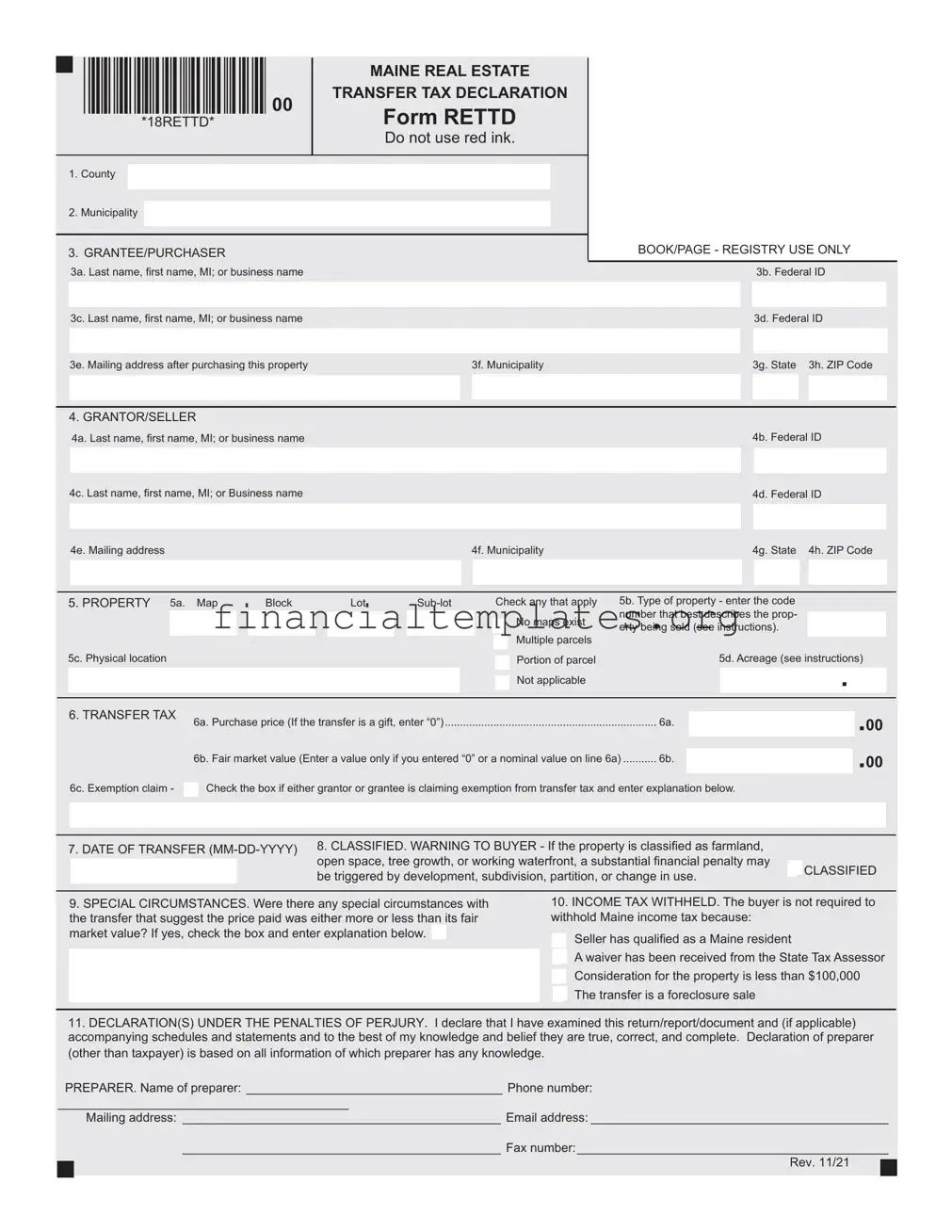The Maine Real Estate Transfer Tax Declaration is closely related to the Uniform Residential Loan Application used in the mortgage industry. Both documents require detailed information about the property involved, including its location, type, and in some instances, its value. Similar to the Real Estate Transfer Tax Declaration, the loan application also demands personal and financial details about the applicants (or grantee/buyer in the tax form's case) to assess eligibility and compliance with applicable laws.
Another analogous document is the Property Deed, which, like the Maine Real Estate Transfer Tax Declaration, identifies the grantor (seller) and grantee (buyer), alongside the precise location and description of the property being transferred. Both documents are integral to the conveyance process, ensuring legal title is correctly passed and appropriately recorded with local authorities.
The Federal Tax Return for individuals or businesses shares similarities with the Maine Tax Form because both require taxpayer identification information and involve reporting values that may affect tax liabilities. While the Federal Tax Return focuses on income and deductible expenses, the Maine form addresses transaction-specific details to calculate real estate transfer taxes, yet both inform tax obligations to governmental authorities.
A Grant Application is similarly structured to the Maine Real Estate Transfer Tax Declaration in that it necessitates the presentation of detailed information to support a request – for funding in the case of the grant application and for tax calculation in the real estate document. Both require a clear declaration of participants' identities, purposes, and justifications for the request, supporting documentation, and an attestation of the truthfulness and accuracy of the information provided.
The HUD-1 Settlement Statement, used in real estate closing transactions, parallels the Maine form in documenting transaction details, including the sale price and real estate taxes. The HUD-1 outlines charges paid by the buyer and seller, closely mirroring the tax declaration's purpose of summarizing financial aspects of the property transfer, albeit with a broader scope on the financial settlement.
Commercial Lease Agreements bear resemblance to the Maine form in the detail required about the property and the parties involved in a transaction. Both documents outline terms and conditions specific to the property use and transfer – the lease from a lessor to lessee, and the tax document from seller to buyer, involving declarations about the property meant to ensure legal and tax compliance.
Statement of Information forms, typically used in real estate transactions, share similarities with the Maine Tax Form because they collect detailed personal information from the parties involved to prevent fraud and clear titles. This includes names, addresses, and identifying numbers—information crucial for both legal documentation and tax purposes.
Homeowner Association (HOA) Transfer fees documentation, requiring the declaration of ownership changes within an HOA jurisdiction, has parallels with the Maine Real Estate Transfer Tax Declaration. Both involve processing fees based on property or membership transfers and necessitate detailed property and ownership information to ensure accurate record-keeping and compliance with applicable rules or laws.
The IRS Form 709, United States Gift (and Generation-Skipping Transfer) Tax Return, while focusing on the transfer of gifts, resembles the Maine tax form in the necessity of reporting transfers involving real property. Both forms require information on the property's value and the parties' identities to calculate and enforce tax liabilities arising from the transfer of valued assets.
Lastly, the Seller's Disclosure Statement, which sellers provide to buyers disclosing known issues with a property, shares objectives with the Maine Real Estate Transfer Tax Declaration in ensuring transparency in a real estate transaction. Although focusing on different aspects, both documents serve to inform buyers, contribute to fair dealings, and are integral to the process of transferring property rights.


 Check the box if either grantor or grantee is claiming exemption from transfer tax and enter explanation below.
Check the box if either grantor or grantee is claiming exemption from transfer tax and enter explanation below.
 Seller has qualified as a Maine resident
Seller has qualified as a Maine resident A waiver has been received from the State Tax Assessor
A waiver has been received from the State Tax Assessor Consideration for the property is less than $
Consideration for the property is less than $ The transfer is a foreclosure sale
The transfer is a foreclosure sale